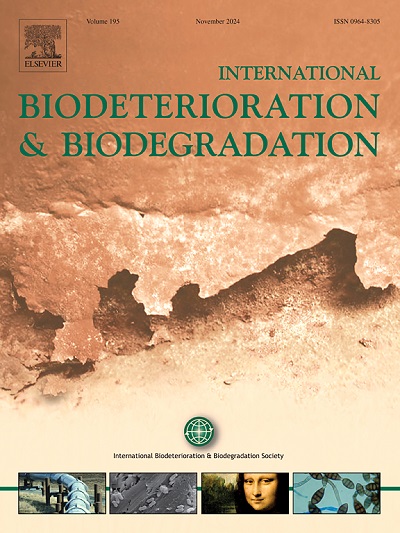巴西东北部热带地区历史建筑上生物营养性生物膜的宏基因组学和形态学分析
IF 4.1
2区 环境科学与生态学
Q2 BIOTECHNOLOGY & APPLIED MICROBIOLOGY
International Biodeterioration & Biodegradation
Pub Date : 2025-06-10
DOI:10.1016/j.ibiod.2025.106143
引用次数: 0
摘要
从巴西赤道地区的三座16和18世纪建筑、巴伊亚州萨尔瓦多的两座石灰石教堂和帕拉州贝尔萨姆的一座砂岩堡垒的表面采集的深色生物膜样本,使用宏基因组学、光学显微镜和场发射扫描电子显微镜(FESEM)和能量色散x射线光谱(EDS)对其进行了表征。蓝藻是优势的殖民菌,Chroococcidiopsis和Trichotorquatus在萨尔瓦多教堂,Aerosakkonema在bel本文章由计算机程序翻译,如有差异,请以英文原文为准。
Metagenomic and morphological analysis of biodeteriogenic biofilms on historic stone buildings in the tropical north-east of Brazil
Samples of dark-colored biofilms collected from the surfaces of three 16th and 18th century buildings in equatorial Brazil, two limestone churches in Salvador, Bahia, and a sandstone fort in Belém, Para, were characterized using metagenomics, light microscopy and field emission scanning electron microscopy (FESEM) with energy-dispersive X-ray spectroscopy (EDS). Cyanobacteria were dominant colonisers, Chroococcidiopsis and Trichotorquatus on Salvador churches, and Aerosakkonema on the Belém fort. Actinomycetes and extremophiles were more common in hotter and more humid Belém than in Salvador. Major fungal sequences represented Sordariomycetes and Dothideomycetes, the latter being more frequent in Belém. The presence of several bacterial species and of the diatom Humidophila contenta are reported for the first time on historic stone buildings. Apart from microbially induced discoloration, biogenic deposits of goethite and possibly pyrite were found within the stone, contributing to its biodeterioration.
求助全文
通过发布文献求助,成功后即可免费获取论文全文。
去求助
来源期刊
CiteScore
9.60
自引率
10.40%
发文量
107
审稿时长
21 days
期刊介绍:
International Biodeterioration and Biodegradation publishes original research papers and reviews on the biological causes of deterioration or degradation.

 求助内容:
求助内容: 应助结果提醒方式:
应助结果提醒方式:


